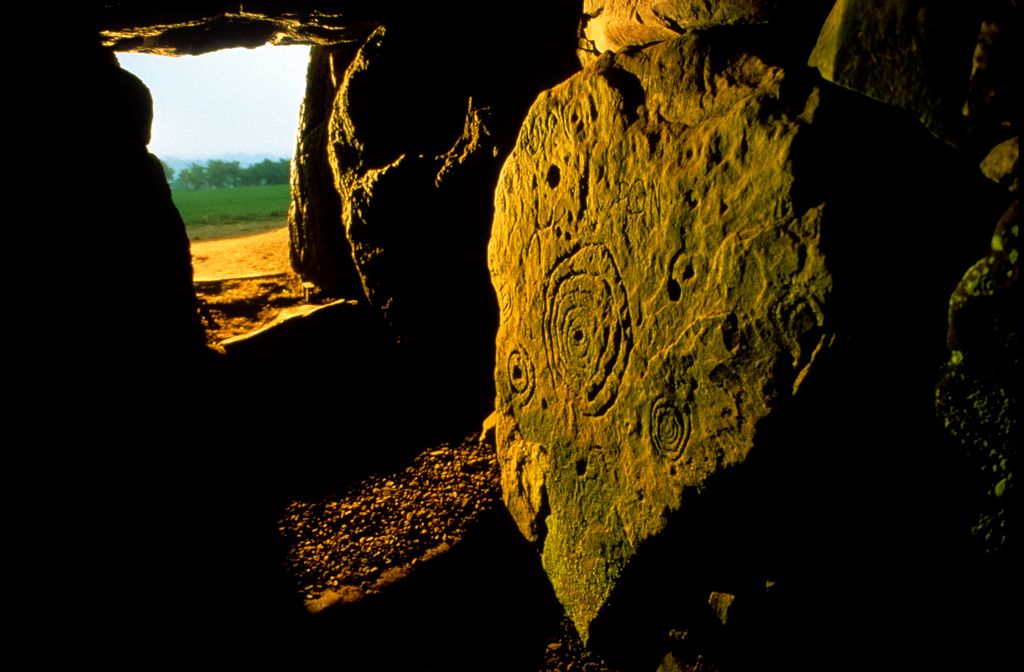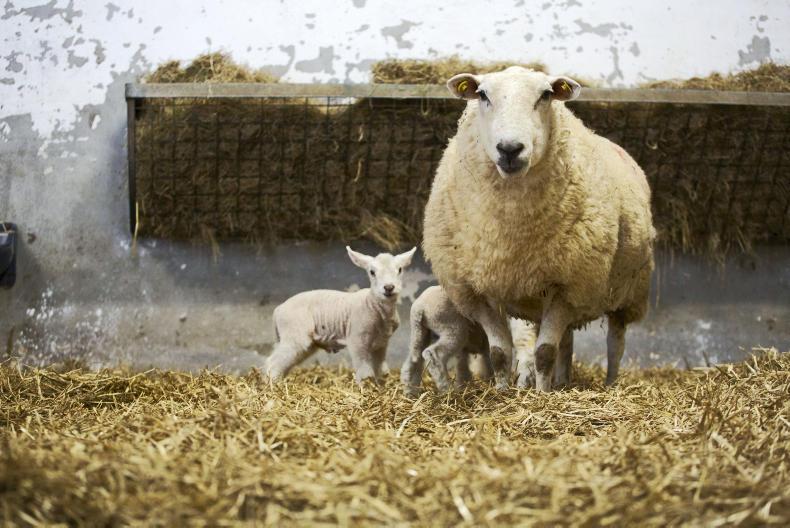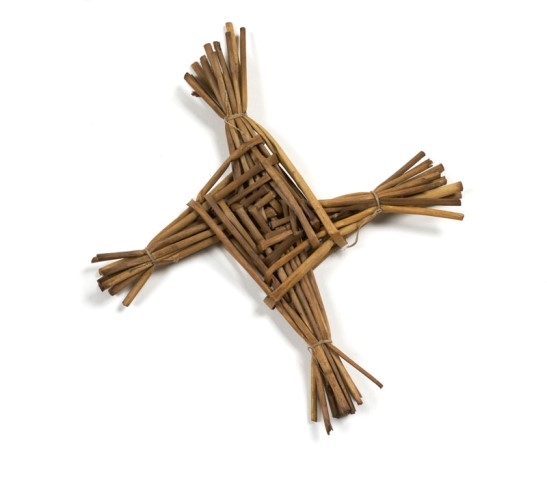Arcadia Ireland
Imbolc and Saint Brigid

Many of us have been feeling the January blues these last few weeks. In the darkest, coldest time of the year, with the light and warmth and conviviality of the Christmas season behind us for another twelve months and springtime nowhere in sight, many were feeling at our lowest. Now that February is upon us and there is, as the Irish put it, “a grand stretch in the evenings”, our collective thoughts begin to turn to the possibilities of the new year ahead.
It is easy to think of the January blues as a modern phenomenon – specific to office workers with bulging waist lines counting the days to their next pay check after the excesses of December – but the fact is that the ancient Irish must have experienced very similar emotions thousands of years ago. The clue for this is in the observance of a pagan festival originating in the stone age.

The pre-Christian calendar was equally divided by four great feasts: Imbolc, Beltaine, Lughnasa and Samhain.
The first of these, Imbolc, takes place on 1 February. Astronomically, Imbolc marks a so-called cross quarter day, the precise mid-point (which in practice can occur any time between 2 and 7 February) between the Winter Solstice and the Spring Equinox. That date was clearly important as far back as the neolithic period. We know this because the significance of the date has been literally set in stone. In the Mound of the Hostages, one the great neolithic monuments at Tara in the Boyne Valley, Imbolc is one of the dates when the sun is aligned directly with the entrance passage to illuminate the inner chamber. The only other date on which this happens is 1 November, the cross quarter day halfway between the Autumn Equinox and the Winter Solstice – a date also write large in the pagan calendar as the Samhain, the festival that marked the start of winter.


The astronomical significance of the date is only part of the story. The cyclical calendars of ancient cultures usually revolve around seasonal changes in nature and the farming practices associated with the different seasons. For the ancient Irish, Imbolc marked the end of the season of darkness and the start of the new agricultural year. The annual festival anticipated the rebirth of nature, and for farmers it marked the start of a new cycle of planting, growing and harvesting. Six months later, the harvest season that culminated the farming year was heralded by the great pagan festival of Lughnasa (1 August). The pagan farmers of the neolithic would have a huge celebration to augur good luck for the coming harvest – a tradition that survived the arrival of Christianity, as pagan and Christian traditions co-existed in rural Ireland for centuries. To Irish and international audiences alike, the most vivid illustration of the shape these celebrations could take on in mid-to-late 20th-century Ireland is probably that presented in Brian Friel’s best-loved play, Dancing at Lughnasa.

Imbolc was the date when farmers would begin preparations for the new farming year. This was the time of year when the new season’s seed potatoes were prepared and horses were taken to be shoed. Even the etymology of the name of the festival, “Imbolc”, has its roots in the physical realities of new births and new beginnings. The name is most commonly believed to derive from the Old Irish “i mbolc”, which translates into English as “in the belly” – referring to the start of the lambing season, when sheep begin to lactate and get ready to give birth.

In these various ways – astronomical and agricultural – Imbolc was the festival of new light and new beginnings.
In a word: Imbolc marked the start of spring. This is why even today, Irish schoolchildren are told that the start of Spring is the 1 February – an assertion that can baffle visitors to these shores, who have more than likely been taught that spring begins (in the northern hemisphere, at least) on 21 March, the date of the Spring Equinox (when the sun is directly above the equator, which means that the day and night are exactly the same length).
Rather than the astronomical start of spring at the Spring Equinox which is the more usual way of indicating the start of the new season in the western world today, the Irish have maintained the older way of reckoning the start of spring tied to the farming calendar.
*
But this event from the pagan calendar is not the only thing the Irish celebrate on the first day of February. Like many pagan traditions, the festival of Imbolc was not eradicated with the arrival of Christianity. The early Christian missions knew that it was much easier to appropriate and re-package established customs and festivals than it was to stamp them out and replace them with something completely new and alien. (This is what the Irish novelist John McGahern was referring to when he used to say that ordinary people in Ireland had always “[gone] about their sensible pagan lives” no matter what the dominant belief system was, knowing deep down that Christianity, like the pagan religion it replaced, was merely “one of the many veneers they had to pretend to wear, like all the others they had worn since the time of the Druids.”) And so the essence of the old pagan festivals was grafted onto new Christian feast days.
The most famous example of this is probably the way the winter festivals of pagan Europe were turned into a celebration of the birth of Christ, as both the timing and the rituals of Christmas owe much to their pre-Christian predecessors. Something similar happened to Imbolc. The Irish spring festival of Imbolc had traditionally honoured a Celtic goddess called Brigid (or Brigit), who it was thought brought fertility to the land. Instead of eradicating that existing figure, the early Irish church simply transformed the pagan goddess Brigit into a Christian Saint and made Imbolc into the feast day of Saint Brigid.

In order to incorporate this newly formed Christian saint into the hagiography of early Christianity, a number of miracles were attributed to Saint Brigid – many of them known by Irish school children to this day. It is striking, though, that none of the records of Brigid’s life or the miracles with which she became associated were recorded during or anywhere near her lifetime. The earliest record was written down Cogitosus around 650AD, two centuries after the events they describe.
Supposedly the daughter of an Irish nobleman, as a young girl she reputedly fed beggars and dogs with bacon and eggs from the family stores and then miraculously replaced what she had taken. In later life she is said to have fed the hungry and cured the blind and the mute in ways reminiscent of episodes from the gospels. (Although in a style befitting an Irish saint, she did not turn water into wine. Instead, she used her knowledge of brewing to turn water into beer. This is why Brigid is the patron saint of – among many other things – brewers.) The best known miracle attributed to her is probably the story about the foundation of her convent in Kildare. According to Cogitosus’ hagiography, Brigid asked the King of Leinster for a fertile plot of land beside a forest and a stream to build a convent. When the king refused, she asked him if he would at least give her as much land as her cloak would cover. The king agreed, but was unpleasantly surprised when Brigid handed each of the four corners of her cloak to one of her followers, who each walked to a far corner of the plot of land for which she had petitioned the king . The cloak did not rip but grew miraculously to cover the entire site, and the king was forced to concede. Brigid built her convent, and eventually the king himself converted to Christianity.
*
The tasks that had needed to be accomplished on the farm in preparation for the year ahead since time immemorial did not change with the introduction a new holy name on the calendar. Old customs remained in place, and were joined by new stories about a Christian saint, new symbols and new customs – many of which have a distinctively pagan feel about them.
The seemingly random list of things of which St Brigid is the patron saint is telling in this respect. These include not only sailors, scholars, midwives and Irish nuns, but also a host of things with a distinctly agricultural flavour, like dairymaids, cattle and chicken farmers. She is also the patron saint of blacksmiths, and one custom observed around Ireland is to place a horseshoe in the fire overnight on Saint Brigid’s night and leave the horseshoe curved side down on the front door of the house for good luck. No doubt, this element of the customs and beliefs surrounding the Christian saint go back to the older, practical custom of taking horses to be shoed in preparation of the new farming season at Imbolc.
Many of the customs associated with St Brigid’s Day deep into the 20th century were shrouded in a distinct aura of superstitious pagan belief. Records of many St Brigid’s Day customs from all around the island of Ireland can be accessed in the National Folklore Collection a free-to-access online resource which preserves recollections of folk traditions and beliefs for future generations – such as this account from the Schools Collection, recorded by a school teacher in County Waterford in 1937-38:
A very common custom in this part of the country is the hanging-out of a ribbon or a piece of cloth on the night before St. Brigid's Day.
It is said that St. Brigid comes along and blesses it on that night. This ribbon or piece of cloth is supposed to be a cure for headache and sorethroat. It was usually titled by the old people as the “Brac Brigde.”
Another custom long ago was; spreading freshly cut rushes out side the door for St. Brigid to walk upon when she was entering the house.

However, the most iconic image associated with Saint Brigid in the popular imagination of Irish people of all ages is the Saint Brigid’s cross. Undoubtedly another example of the way the early church found a way of using local vernacular materials and styles to replicate its own iconography, Saint Brigid’s cross does not share the shape of the conventional symbol of Christianity – the straight cross with shorter extremities at the top and sides and a longer bottom leg modelled on an instrument of torture favoured by the Roman Empire. The cross named after this female Irish saint is most commonly made from reeds or rushes (though regional variations on the choice of material did exist), a material widely available among all population groups in early-Christian Ireland. These humble materials were tied together in the shape of a cross, most commonly in the four-armed a-symmetrical design pictured below – although other designs were also found. (The National Museum of Ireland has examples of different known variations on the Saint Brigid’s cross.)

These humble-looking homemade crosses would traditionally be sprinkled with holy water and hung in homes and animal sheds. It would not be unheard-of either for leftover straw that had been touched by holy water to be mixed into the straw on which farm animals slept at night. This way, the patron saint looked after the family’s livestock.
While they are rarely sprinkled with holy water nowadays in our increasingly secularised new century, Saint Brigid’s crosses remain part of the iconography of Ireland. School children in many schools still make Saint Brigid’s crosses around this time of year, and many of these decorate the houses of Irish people of all religions and classes. And while the religious convictions and beliefs that underpin this practice are on the wane, the custom is still relevant as a way of reinvigorating national identity, of connecting with ancestry and with the customs and traditions that have existed on this island for many centuries.
In a way, the secularisation of Saint Brigid’s cross and Saint Brigid’s Day – from 2023 onward the occasion of Ireland’s newest annual Bank Holiday – are merely another version of the way cultural practices adapt in order to survive into a new age in the same way that Imbolc had to change into Saint Brigid’s Day in order to survive the advent of Christianity.
Old festivals can assume new meanings even as the old ones are not completely forgotten. The introduction of the new Saint Brigid’s Day Bank Holiday in Ireland this year is an interesting case. After a couple of decades that saw dwindling church attendance and a waning of religious belief, the decision to name the new public holiday after a Christian saint was an interesting one – as is the emphasis which the festival newly created in Brigid’s name has taken on. The first paragraph of the official press release from the Department of Tourism, Culture, Arts, Gaeltacht, Sport and Media highlights the fact that this is “the first Irish public holiday named after a woman”, and that as such it “provides a unique opportunity to acknowledge the critical role that women have played in Irish history, culture and society. […] As such, this bank holiday carries a dual opportunity to recognise the role of women through our arts and cultural heritage.”
So as we continue to think of 1 February as the end of the season of darkness and the start of Spring, as the neolithic farmers who built the monuments on the Hill of Tara did, and as our children continue to make Saint Brigid’s crosses, we are adding yet another layer of meaning to the same date by recognising the humanity – rather than just saintliness – of Saint Brigid, and specifically her potential as a role model for strong, resourceful womanhood. This kind of thinking is at the core of the Herstory campaign that sees public buildings not only in Ireland but in places around the globe with a strong presence of the Irish diaspora lit up with images in spectacular fashion (as in the image above, which shows the GPO on Dublin’s O’Connell Street.)
It is for all these reasons – backward-looking to the neolithic and early-Christian past and forward-looking to the society we want to be into the future – that it is relevant to pause at the significance of this date.